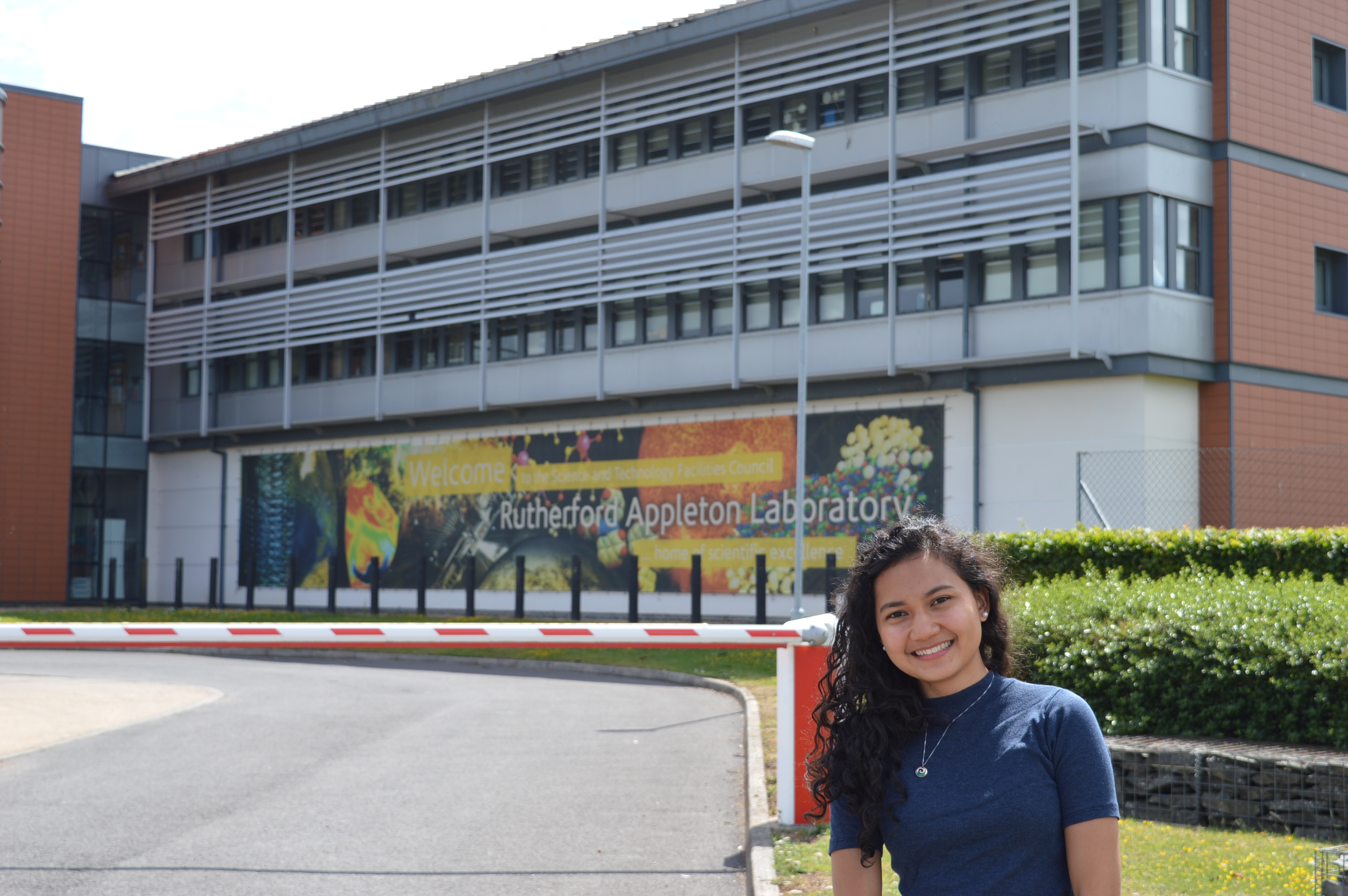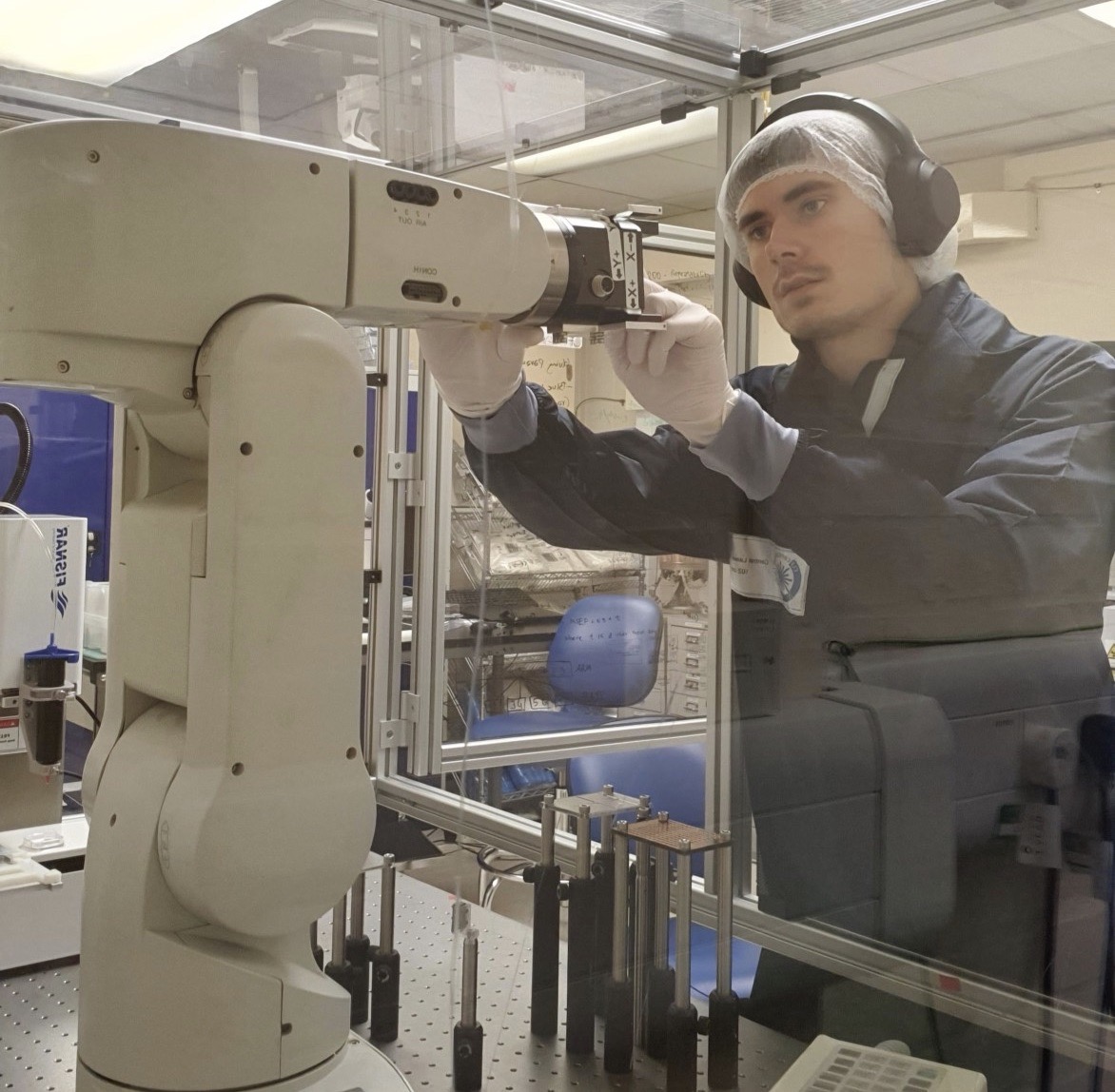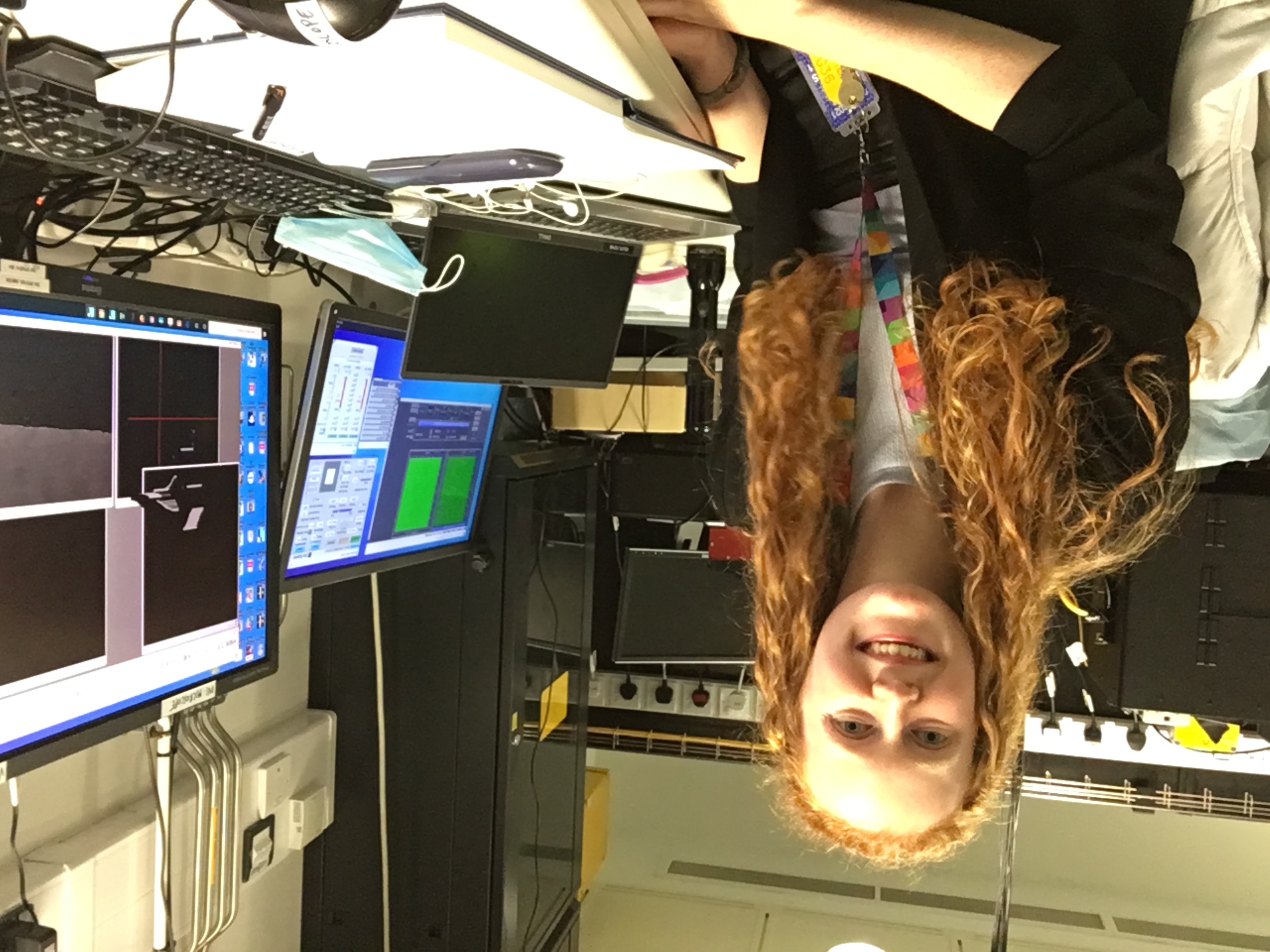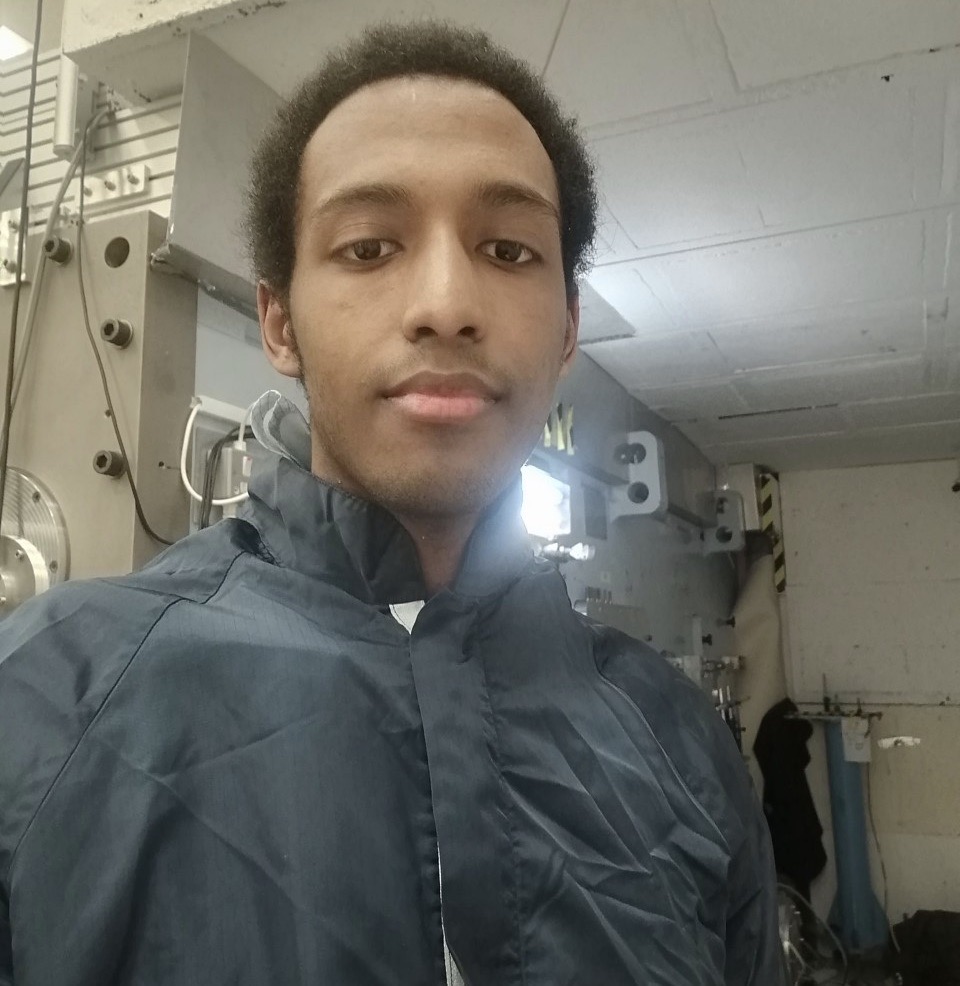STFC employs approximately 70 sandwich students each year, based at three sites across the UK. In order to use and develop skills they have acquired at university within a working environment the Sandwich Student Scheme is offered to undergraduates. I got to sit down with some of the Central Laser Facility's (CLF's) students and discuss their roles with them. The aim with this feature is to give an insight into what it's like being a sandwich student for the CLF.
Student Profiles:
- Viviene Marie Dela Cruz is pursuing Electrical and Electronic Engineering at City, University of London and is currently a development scientist for a high energy laser.
- Tuege Neumann is doing an Integrated Masters in Mechatronic Engineering at the University of Manchester and works at the target fabrication group as a laser target engineer.
- Ellen Clancy has completed her 2nd year at the University of Birmingham in Biological Sciences and is currently working on a project to study the effect of induced DNA damage through lasers and its repair process at the OCTOPUS Imaging Cluster.
- Daniel Bedilu has completed the 2nd year of his Integrated Master's in Physics at the University of Bath and is working as a laser-plasma physicist for Vulcan.
What do you do in your job?
VIVIENE: My job is to develop a laser diagnostic set up in the lab. This includes both developing an algorithm and also implementing it physically on a high energy laser.
TUEGE: My main project is automating the production High Repetition Micro Laser Targets. I also look after the 3D printing in the target fabrication group.
ELLEN: I'm working on a project with a particular focus on the application of anisotropy and a technique called fluorescence lifetime imaging microscopy. I will use the technique to focus on the dimerization and accumulation of a protein called Ku, a protein involved in DNA damage and repair.
DANIEL: I'm supporting users running their experiments in the Vulcan target areas by helping with build-up diagnostics or RCF stacks for measuring photon energies. I'm also working on a project to build up a new type of spectrometer.

Viviene Marie Dela Cruz in front of the Rutherford Appleton Laboratory. Image Credit: STFC
What is the most exciting part of your job?
VIVIENE: I love the different kinds of discussions I get to have with people in my group because it makes me appreciate the work I'm doing. I also look forward to learning new things every day, since it's so fulfilling looking back at the progress from 3-4 months.
TUEGE: The most exciting part of my job is working with so many intelligent people and learning to use all the instruments and equipment here. It makes you feel like you're a part of cutting-edge science.
ELLEN: Applying my knowledge from university in a technical environment is quite enjoyable for me. It's also much more enjoyable because the research we're conducting is so innovative in my field.
DANIEL: The most exciting part for me is that I can be very involved and hands-on with most of the experiments. At university, most of your learning is to get a mark, but at the CLF I get to be a relevant part of an experiment and be a part of the physics world.

Tuege Neumann working on a robotic assembly system. Image Credit: STFC
What do you find challenging about your job?
VIVIENE: I'm working on a method developed by a colleague for my main project, no previous placement student has worked on it fully before. Given my engineering background, it's both challenging and exciting because it's my responsibility to shape the project way I want to. I'm also in charge of setting my deadlines and evaluating my learning, which at times can be challenging because it's completely different from a university environment.
TUEGE: At university all the work we do is graded and has a correct answer, whereas that framework doesn't apply to my placement. You have to go out of your way to explore a concept and work out an answer yourself. Within that, there is a huge learning process that you go through yourself. Sometimes some people can guide you and other times the learning is all in your hands, which can be quite challenging at times.
ELLEN: I have a biology background, and there is a very big focus on physics and engineering here. Sometimes I have to ask about some of the technical aspects of the project, but everyone here has been very accommodating in ensuring I'm up to speed.
DANIEL: When you first walk into the lab, it can be very overwhelming familiarising yourself with all the systems and procedures. So, you have to learn to take it slowly and accept you won't get everything done at once, and that you build up that understanding over time.

Ellen Clancy using the confocal and fluorescence lifetime imaging software (FLIM) to analyse live cells fused to fluorescent proteins. Image Credit:STFC
Why did you apply for a placement at the CLF?
VIVIENE: I knew I wanted to do a placement, but I wasn't sure if I wanted it to be research-based. When I read the job descriptions, I remembered thinking that even though I didn't have much knowledge on lasers, the project sounded very interesting and it would be an amazing opportunity to try something new.
TUEGE: For me, it was very clear that I would like to do a placement where I would be put in charge of a project where I could do something tangible. Some companies allow you to get involved in science, but whatever you accomplish doesn't have much chance of being applied or implemented. Working on my project at the CLF means that I get to work on a project that will be impactful in improving in-house capabilities.
ELLEN: I wanted to do a placement so I could get an insight into what sort of career I wanted and what field I wanted to work in. I specifically applied for this role because it had a good balance of microscopy, working with lasers, and cell culturing. It was also a great opportunity to get involved in something completely out of my comfort zone.
DANIEL: I've always been interested in pursuing some sort of research as a career path, but I wasn't 100% sure if it was for me. I saw STFC had a placement in optics, which is something that I'm keen on, so I decided to apply.

Daniel Bedilu in front of the TAP target chamber. Image Credit: STFC
What do you hope to gain from the placement?
VIVIENE: I want to have a better understanding of the research community and what drives their hard work and curiosity. Also, a wider perspective of the technical applications because we learn about most of the concepts from a theoretic standpoint at university.
TUEGE: I wanted an insight on whether research is for me and get a better understanding of the technical field. One of the things I've realised through this role is that I like the work I do and the science. It's not just people with lab coats working away in their lab; it's about the process. From building an instrument, collating, and analysing a dataset to then applying it to solve a real-life problem.
ELLEN: I hope to make the most of new opportunities and learn new things. I also hope to see the 'behind-the-scenes' of undertaking an experiment – from lab work to data set building, to verifying results, and then getting published.
DANIEL: I want to gain an understanding of what a career in experimental research would be like, and so far it's been very enjoyable. Aside from that, I hope to gain practical skills that I can carry forward into university and then employment; stuff like the teamwork aspect of working here is super useful.
At the moment, do you have any specific career aspirations?
VIVIENE: Originally, I only thought of engineering careers, but my placement has made me expand further career options in a couple of fields-including further study and research, so it's difficult to say right now. I anticipate I will learn more about which path I want to pursue as I do my placement and finish my degree.
TUEGE: At STFC, scientists tend to follow their curiosity to initiate projects, which is refreshing, so I'm definitely considering STFC as an option. That being said, I'm also open to other options.
ELLEN: At the moment, I'm focused on completing my project and exploring my options to making a well-informed decision by next year.
DANIEL: I know I enjoy doing research and working in areas where I can get hands-on experience, but I haven't pinpointed what I would exactly want to do next.
We look forward to the work that the 2020/2021 team of sandwich students will complete and wish them well in all they do.
Further information about the variety of opportunities that STFC offers undergraduate students can be found by following this link.
